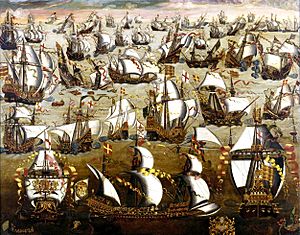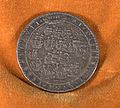Spanish Armada facts for kids
Quick facts for kids Spanish Armada |
|||||||
|---|---|---|---|---|---|---|---|
| Part of the Anglo-Spanish War (1585–1604) and the Eighty Years' War | |||||||
|
The Spanish Armada and English ships in August 1588, (unknown, 16th-century, English School) |
|||||||
|
|||||||
| Belligerents | |||||||
| Commanders and leaders | |||||||
| Strength | |||||||
|
|
||||||
| Casualties and losses | |||||||
Battle of Gravelines:
|
Battle of Gravelines:
|
||||||

The Spanish Armada was a huge fleet of ships sent by King Philip II of Spain in 1588. His goal was to invade England and remove Queen Elizabeth I from her throne. The Armada was defeated by the Royal Navy of England. This important event happened between July and August 1588.
The English fleet was led by Lord Howard of Effingham. His second-in-command was Sir Francis Drake. A famous story says that when Drake heard about the Armada's approach, he was playing bowling. He calmly said there was still time to finish his game and then defeat the Spanish.
The Spanish Armada was commanded by the Duke of Medina Sidonia. He was not a naval expert. He took over after the original commander died in February 1588.
Contents
How Was the Spanish Armada Defeated?
The defeat of the Spanish Armada was caused by several factors. These included smart English tactics, better ships, and bad weather. The Spanish had a very large fleet, but they could not use their numbers to their advantage.
English Ship Advantages
The English had fewer ships, only about 55. However, these ships were often bigger and carried more powerful guns. The Spanish ships, called galleons, had cannons that could only fire short distances. The English ships had long-range cannons.
Part of the English plan was to damage or sink enemy ships from far away. This meant the Spanish could not get close enough to fire back effectively. English ships were also easier to steer and move quickly. This made them more agile in battle.
The Role of Weather
A severe storm played a big part in the Armada's defeat. The storm scattered the Spanish ships before they could fully meet the English fleet. This made it harder for them to fight together as planned. After the main battles, more storms hit the Armada as it tried to sail home around Scotland and Ireland. Many Spanish ships were wrecked on the coasts.
English Morale and Leadership
The English sailors had high spirits and were very loyal. Queen Elizabeth I gave a famous speech that boosted their confidence. Their captains were experienced and had fought in many naval battles before. This strong leadership and dedication helped them win.
What Happened After the Battle?
Even though the English sailors fought bravely and won, they faced problems afterward. They did not get paid for their service. They were also told to stay on their ships to "guard" against another possible Spanish attack.
Lord Howard of Effingham was upset when he learned his sailors were not paid. He said he would rather have no money himself than see his sailors go without. King Philip II of Spain died in 1598, ten years after the Armada's defeat.
Images for kids
-
Philip II of Spain around 1580
-
Sir Francis Drake in 1591
-
The Spanish Barn in Torquay held 397 Spanish prisoners of war
See also
 In Spanish: Armada Invencible para niños
In Spanish: Armada Invencible para niños












